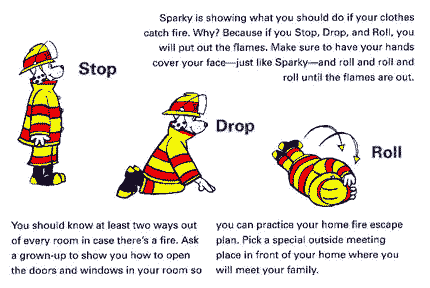Fire Fighting Tips
All fires can be
very dangerous and life-threatening. Your safety should always be your
primary concern when attempting to fight a fire.
Before deciding to fight a fire, be certain that:
Smoke inhallation or exposure to fire itself can be life threatening so get educated about the basics in CPR and burn treatment.
Pull the Pin at the top of the extinguisher. The pin releases a locking mechanism and will allow you to discharge the extinguisher.
Aim at the base of the fire, not the flames. This is important - in order to put out the fire, you must extinguish the fuel.
Squeeze the lever slowly. This will release the extinguishing agent in the extinguisher. If the handle is released, the discharge will stop.
Sweep from side to side. Using a sweeping motion, move the fire extinguisher back and forth until the fire is completely out. Operate the extinguisher from a safe distance, several feet away, and then move towards the fire once it starts to diminish. Be sure to read the instructions on your fire extinguisher - different fire extinguishers recommend operating them from different distances. Remember: Aim at the base of the fire, not at the flames!!!!
Before deciding to fight a fire, be certain that:
 The fire is small and not spreading. A fire can double in size within two or three minutes.
The fire is small and not spreading. A fire can double in size within two or three minutes.
- You have the proper fire extinguisher for what is burning.
- The fire won't block your exit if you can't control it. A good way to ensure this is to keep the exit at your back.
- You know your fire extinguisher works. Inspect extinguishers once a month for dents, leaks or other signs of damage. Assure the pressure is at the recommended level. On extinguishers equipped with a gauge, the needle should be in the green zone - not too high and not too low.
- You know how to use your fire extinguisher. There's not enough time to read instructions when a fire occurs.
- Always stand with an exit at your back.
- Stand sevevvral feet away from the fire, moving closer once the fire starts to diminish.
- Use a sweeping motion and aim at the base of the fire.
- If possible, use a "buddy system" to have someone back you up or call for help if something goes wrong.
- Be sure to watch the area for awhile to ensure it doesn't re-ignite.
- The fire is spreading rapidly. Only use a fire extinguisher when the fire is in its early stages. If the fire is already spreading quickly, evacuate and call the fire department.
- You don't know what is burning. Unless you know what is burning, you won't know what type of fire extinguisher to use. Even if you have an ABC extinguisher, there could be something that will explode or produce highly toxic smoke.
- You don't have the proper fire extinguisher. The wrong type of extinguisher can be dangerous or life-threatening.
- There is too much smoke or you are at risk of inhaling smoke. Seven out of ten fire-related deaths occur from breathing poisonous gases produced by the fire.
Smoke inhallation or exposure to fire itself can be life threatening so get educated about the basics in CPR and burn treatment.
 |
P
|
A
|
S
|
S
|
Aim at the base of the fire, not the flames. This is important - in order to put out the fire, you must extinguish the fuel.
Squeeze the lever slowly. This will release the extinguishing agent in the extinguisher. If the handle is released, the discharge will stop.
Sweep from side to side. Using a sweeping motion, move the fire extinguisher back and forth until the fire is completely out. Operate the extinguisher from a safe distance, several feet away, and then move towards the fire once it starts to diminish. Be sure to read the instructions on your fire extinguisher - different fire extinguishers recommend operating them from different distances. Remember: Aim at the base of the fire, not at the flames!!!!
No comments:
Post a Comment